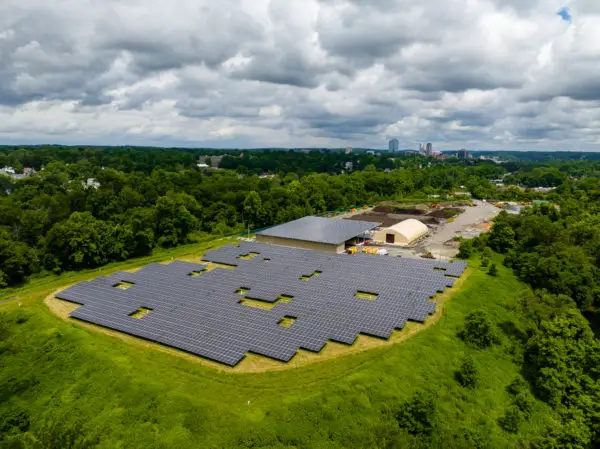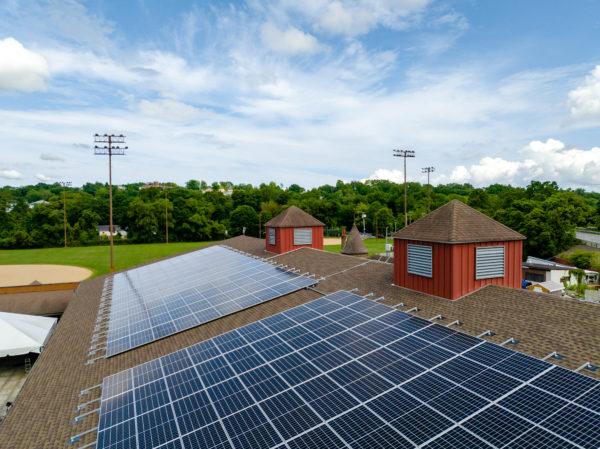Solar system for White Plains completed
Construction has been completed on what”™s described as the largest municipal solar energy setup in Westchester County. The system is spread over nine city-owned sites in White Plains. It is designed to produce 8,100 megawatt hours of electricity each year. A megawatt hour is one million watts of electricity produced for a one-hour period. One million watts is enough to light more than 9,000 standard 100 watt bulbs in a 110-volt system.

The system was built by Distributed Solar Development (DSD) based in Schenectady, which the city selected after having sent out a Request for Proposals (RFP) to about 100 solar contractors. The RFP was prepared by the city”™s Department of Public Works (DPW) with the cooperation of the New York Power Authority (NYPA), which has its administrative offices in White Plains. The city”™s DPW commissioner at the time, Rick Hope, described DSD as being a “spin-off” of GE Solar.
The city says that the amount of electricity to be generated is enough to power more than 700 homes each year.
The nine solar projects include a mix of canopy, rooftop and ground mount installations at four parking garages, the Ebersole Ice Rink, Gedney Way Recycling Yard, Gillie Park, the city Water Department and the Brockway Place DPW site.

When the project was getting started, White Plains Mayor Tom Roach told the Business Journals that the city will be receiving about $1 million a year in revenue from leasing the spaces occupied by the solar sites and will have no costs associated with them.
Upon completion of the build-out, Roach said, “We are in a climate crisis and are obligated to recognize the urgency and take deliberate action to build a sustainable, resilient planet. The city of White Plains will continue to serve as a sustainability leader by investing in and implementing renewable energy initiatives that will meaningfully reduce greenhouse gas emissions.”
Justin E. Driscoll, interim president and CEO of NYPA, said, “The New York Power Authority is pleased to have played a key role in helping the city of White Plains create an expansive, unique portfolio of solar and storage systems that offer renewable energy to reduce the region”™s carbon footprint. As the commercial hub of Westchester County, White Plains is setting an example for other communities looking to develop alternative clean energy options. Hopefully, other municipalities will follow suit and help our state further advance its bold climate action goals.”
David Eisenbud, senior organization director at DSD, had pointed out that two-thirds of the White Plains sites consist of garage top and surface parking canopy systems.
“This is a specialty application that DSD has pioneered,” Eisenbud said. “This will help transform the city. DSD doubled the expected capacity on city parking garages because of our propriety solar canopy designs.”
He said the canopies over parking areas will do more than just provide a platform for solar panels; they will protect people and vehicles from rain and snow while enhancing the downtown experience for visitors.
After completion of the project, Eisenbud said, “This unique portfolio positions the city as a leader in solar adoption and shows other communities what is possible when it comes to clean energy.”
Some of the solar installations incorporated infrastructure improvements, such as a new roof for the Ebersole Ice Rink and a storage area for the water department. The canopies across some of the sites feature a proprietary integrated water management system to handle flowing water from rain and snow melt. The solar field at the Gedney Recycling Facility features the first floating foundation canopy mounted on a landfill cap. Additionally, two canopy systems at the site incorporate sidewalls to store and protect city equipment. In construction, a floating foundation does not use footings. It is a slab with edges that go just below the frost line. This type of foundation is able to move as temperatures cause the soil to compact and expand.
City officials and DSD had said they expect the solar system will not only reduce dependence on fossil fuels for electricity generation but also produce environmental benefits equivalent to removing about 1,300 cars from the road or planting 101,000 new trees in White Plains.